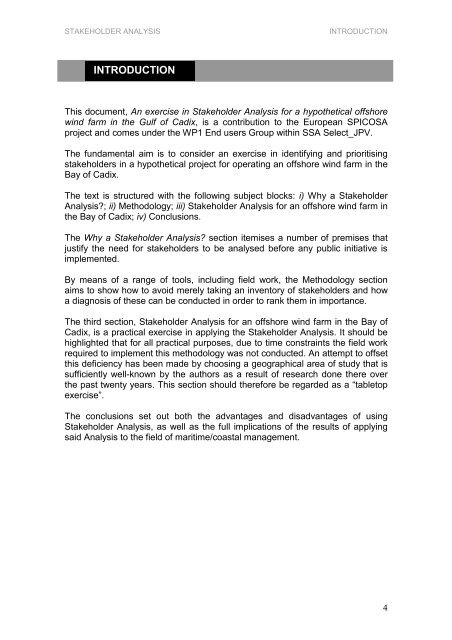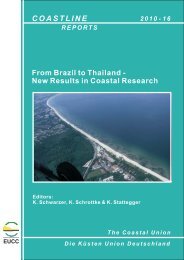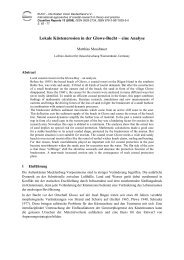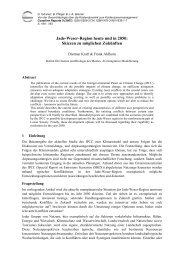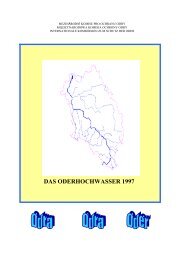An exercise in Stakeholder Analysis for a hypothetical offshore wind ...
An exercise in Stakeholder Analysis for a hypothetical offshore wind ...
An exercise in Stakeholder Analysis for a hypothetical offshore wind ...
Create successful ePaper yourself
Turn your PDF publications into a flip-book with our unique Google optimized e-Paper software.
STAKEHOLDER ANALYSIS INTRODUCTION<br />
INTRODUCTION<br />
This document, <strong>An</strong> <strong>exercise</strong> <strong>in</strong> <strong>Stakeholder</strong> <strong>An</strong>alysis <strong>for</strong> a <strong>hypothetical</strong> <strong>offshore</strong><br />
w<strong>in</strong>d farm <strong>in</strong> the Gulf of Cadix, is a contribution to the European SPICOSA<br />
project and comes under the WP1 End users Group with<strong>in</strong> SSA Select_JPV.<br />
The fundamental aim is to consider an <strong>exercise</strong> <strong>in</strong> identify<strong>in</strong>g and prioritis<strong>in</strong>g<br />
stakeholders <strong>in</strong> a <strong>hypothetical</strong> project <strong>for</strong> operat<strong>in</strong>g an <strong>offshore</strong> w<strong>in</strong>d farm <strong>in</strong> the<br />
Bay of Cadix.<br />
The text is structured with the follow<strong>in</strong>g subject blocks: i) Why a <strong>Stakeholder</strong><br />
<strong>An</strong>alysis?; ii) Methodology; iii) <strong>Stakeholder</strong> <strong>An</strong>alysis <strong>for</strong> an <strong>offshore</strong> w<strong>in</strong>d farm <strong>in</strong><br />
the Bay of Cadix; iv) Conclusions.<br />
The Why a <strong>Stakeholder</strong> <strong>An</strong>alysis? section itemises a number of premises that<br />
justify the need <strong>for</strong> stakeholders to be analysed be<strong>for</strong>e any public <strong>in</strong>itiative is<br />
implemented.<br />
By means of a range of tools, <strong>in</strong>clud<strong>in</strong>g field work, the Methodology section<br />
aims to show how to avoid merely tak<strong>in</strong>g an <strong>in</strong>ventory of stakeholders and how<br />
a diagnosis of these can be conducted <strong>in</strong> order to rank them <strong>in</strong> importance.<br />
The third section, <strong>Stakeholder</strong> <strong>An</strong>alysis <strong>for</strong> an <strong>offshore</strong> w<strong>in</strong>d farm <strong>in</strong> the Bay of<br />
Cadix, is a practical <strong>exercise</strong> <strong>in</strong> apply<strong>in</strong>g the <strong>Stakeholder</strong> <strong>An</strong>alysis. It should be<br />
highlighted that <strong>for</strong> all practical purposes, due to time constra<strong>in</strong>ts the field work<br />
required to implement this methodology was not conducted. <strong>An</strong> attempt to offset<br />
this deficiency has been made by choos<strong>in</strong>g a geographical area of study that is<br />
sufficiently well-known by the authors as a result of research done there over<br />
the past twenty years. This section should there<strong>for</strong>e be regarded as a “tabletop<br />
<strong>exercise</strong>”.<br />
The conclusions set out both the advantages and disadvantages of us<strong>in</strong>g<br />
<strong>Stakeholder</strong> <strong>An</strong>alysis, as well as the full implications of the results of apply<strong>in</strong>g<br />
said <strong>An</strong>alysis to the field of maritime/coastal management.<br />
4


